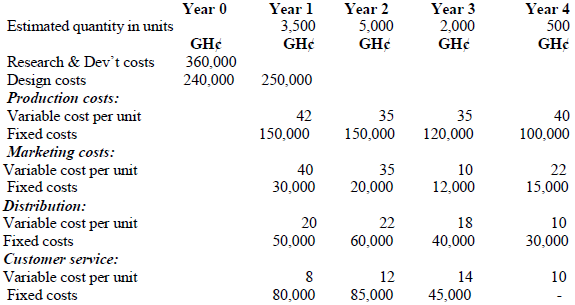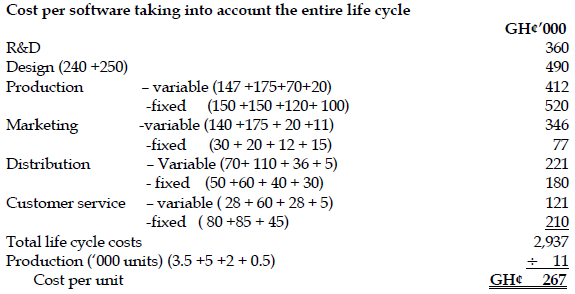Oria Software Ltd, a computer software company is developing a new accounting package, “Future Accounting”. The following are the budgeted amounts for the product over a four-year product life-cycle.

To be profitable, Oria Software Ltd must generate revenues to cover costs for all six-business functions taken together and, in particular, its high non-production costs. The company has therefore proposed a selling price of GH¢ 250 per software over the entire product life cycle.
Required:
i) Explain life cycle costing and identify TWO (2) benefits Oria Software Ltd will derive from using life cycle costing. (3 marks)
View Solution
Life cycle costing is a concept which traces all costs to a product over its complete lifecycle, from design through to cessation. It recognises that for many products there are significant costs to be incurred in the early stages of its lifecycle. This is probably very true for Oria Software Inc. The design and development of software is a long and complicated process and it is likely that the costs involved would be very significant.
Benefits of lifecycle costing
- The profitability of a product can then be assessed taking all costs into consideration.
- It is also likely that adopting lifecycle costing would improve decision-making regarding product introduction, product mix and for discontinuation of the product.
- It is also considered a way to enhance cost control of manufacturing costs.
- It helps in pricing decision therefore preventing underpricing at the launch point.
ii) Calculate cost per software taking into account the entire lifecycle and comment on the proposed selling price. (7 marks)
View Solution

Conclusion:
Clearly, proposed selling price per software of GH¢250 is not advisable as it is lower than cost of production. Oria Software Inc. may either increase the selling price or undertake cost reduction techniques like value engineering, quality cycle or alternative source of cheaper material to be able to reduce the cost to be lower than GH¢ 250 per unit.
